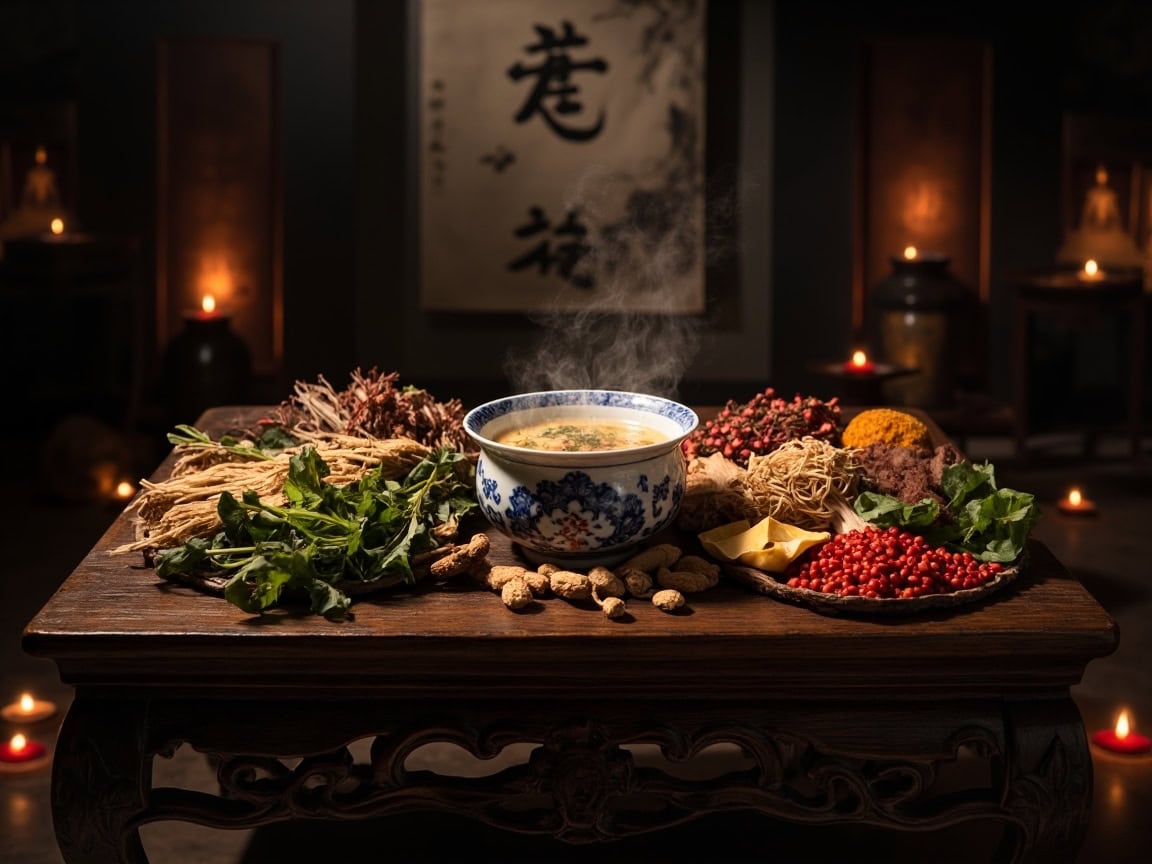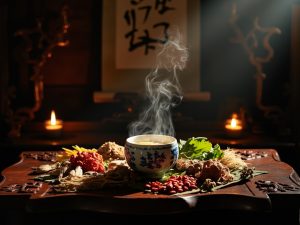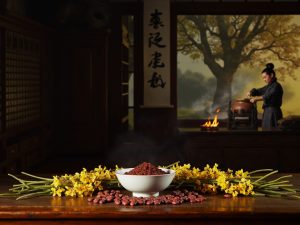Table of Contents
ToggleThe Distinctions and Syndromes of Three Types of Xiexin Tang
Author: Nan Kaiyang Editor: Gu Yuxi Translator: Gu Yuxi
Differentiation of Taiyang Disease Pulse Patterns and Treatment (Part 7)
149. For cold damage of five or six days, with vomiting and fever, where Chaihu Tang syndrome is complete, but the patient was purged with other medicine, and the Chaihu syndrome still remains, give Chaihu Tang again. Although already purged, this is not a contraindication. There will certainly be a steaming sensation and shaking, followed by fever and sweating, leading to resolution. If there is fullness, hardness, and pain below the heart, this is Jie Lei (Bound Accumulation), and Daxiexiong Tang (Major Chest-Binding Decoction) is indicated. If there is only fullness but no pain, this is Pi (Glomus), for which Chaihu is not suitable; Banxia Xiexin Tang (Pinellia Xiexin Decoction) is indicated.
Jinkui Yaolue (Synopsis of Prescriptions of the Golden Chest) Chapter 17: Vomiting, Hiccupping, and Diarrhea
10. For vomiting with borborygmus and epigastric glomus, Banxia Xiexin Tang is indicated.
Banxia Xiexin Tang pertains to a concurrent disease of Yangming and Taiyin. However, this formula precisely treats a syndrome of intermingled cold and heat with deficiency and repletion. This type of complex cold and heat truly belongs to the “cold in spleen, heat in stomach” syndrome. When evil qi invades the middle jiao, according to the differentiation of yin and yang, stomach yang transforms into heat, and spleen yin transforms into cold, forming the syndrome of stomach heat and spleen cold. If spleen qi fails to ascend and stomach qi fails to descend, leading to dysregulation of ascent and descent and obstruction of qi flow, then there is epigastric glomus and fullness. If the spleen fails in its transportation and transformation, and clear qi does not ascend, then there is diarrhea and borborygmus. If stomach qi is disharmonized and turbid qi fails to descend, then there is vomiting. These constitute the key diagnostic points for Banxia Xiexin Tang.
This clause shares similarities and differences with Shengjiang Xiexin Tang. The similarity is that both address disharmony of spleen and stomach qi, with glomus below the heart. The difference is that Banxia Xiexin Tang treats intermingled phlegm and heat, while Shengjiang Xiexin Tang treats evil fluids accumulating below the heart. Clinically, Banxia Xiexin Tang is used for conditions throughout the gastrointestinal tract. “Pi” manifests as upper abdominal discomfort, but palpation reveals a soft, non-resistant feeling, not stony hard or balloon-like. Borborygmus accompanies increased or unformed stools. Commonly, patients have poor appetite, or nausea, even vomiting shortly after eating, or post-meal upper abdominal distension and reflux. Because the pathogenesis manifests as intermingled cold and heat, and its etiology and pathogenesis involve intermingled cold and heat with heat binding in the middle jiao, it is a very representative formula.
Differentiation of Taiyang Disease Pulse Patterns and Treatment (Part 7)
157. For cold damage with sweating leading to resolution, if the stomach is disharmonized, there is epigastric glomus and hardness, dry heaving with a putrid smell of food, water qi in the hypochondrium, borborygmus in the abdomen, and diarrhea, Shengjiang Xiexin Tang (Fresh Ginger Xiexin Decoction) is indicated.
Differentiation of Post-Sweating Disease Pulse Patterns and Treatment, Chapter 17
27. For cold damage with sweating leading to resolution, if the stomach is disharmonized, there is epigastric glomus and hardness, dry heaving with a putrid smell of food, water qi in the hypochondrium, borborygmus in the abdomen, and diarrhea, it pertains to Shengjiang Xiexin Tang.
Shanghan Laisu Ji (Collected Works on Recovery from Cold Damage) interprets this clause as a Taiyang disease with intermingled evil heat, dampness, and fluids, but belonging to the syndrome of stomach heat and spleen cold. The original text states: “Sweating and resolution means the Taiyang syndrome has subsided. Disharmony in the stomach means that residual Taiyang evil and yin-cold water qi are mixed within. Yang evil resides in the upper part of the stomach, thus there is epigastric glomus and hardness, dry heaving, and putrid smell of food. Water evil resides in the lower part of the stomach, thus there is borborygmus in the abdomen and diarrhea. If fire’s function is not dispersed, there is glomus and hardness; if water’s function is not dispersed, there is dry heaving; if evil heat fails to digest food, there is putrid smell of food. The hypochondrium is the abdomen; if Earth is deficient and cannot control water, there is borborygmus. Here, the Taiyang cold-water evil that invaded the superficial part of the body has subsided, but that which entered the interior of the body has not dispersed. Therefore, although the disease is in the stomach, it does not belong to Yangming; it is still a transformation of Taiyang cold-water.”
Note: Epigastric glomus is an interior symptom of Taiyang. Above the Taiyang, cold dominates, and Shaoyin appears in the middle. Shaoyin is the heart, and the heart is the Taiyang within Yang. It must be that the person normally has insufficient heart fire and empty cold in the stomach, thus Taiyang cold-water can invade internally. Empty yang is stagnant and not comfortable, cold evil is congealed and not resolved, and cold and heat struggle below the heart, leading to various complex symptoms, and the “Monarch” (heart) is in danger. Using warmth to attack cold may lead to self-immolation, and using cold to overcome heat may invite further invasion.
The above clauses and their supporting herb uses are applicable for treating water-qi glomus, fluid retention in the intestines and stomach, and when the middle jiao is deficient with evil heat. Unlike Gancao Xiexin Tang, Shengjiang Xiexin Tang is mainly used for treating stagnation of water and food below the heart and in the abdomen, typically manifesting as frequent and strong-smelling burping after meals.
Differentiation of Taiyang Disease Pulse Patterns and Treatment (Part 7)
158. For cold damage or wind-stroke, if the physician mistakenly purges the patient, and the person has diarrhea dozens of times a day with undigested food, borborygmus in the abdomen, epigastric glomus and fullness, dry heaving, and vexation with inability to rest; if the physician sees epigastric glomus and thinks the disease is not resolved and purges again, the glomus will worsen. This is not congealed heat, but merely due to stomach deficiency and rebellious guest qi, which causes the hardness. Gancao Xiexin Tang (Licorice Xiexin Decoction) is indicated.
Jinkui Yaolue (Synopsis of Prescriptions of the Golden Chest) Chapter 3: Baihe, Huxi, Yinyangdu
10. The disease Huxi manifests like cold damage, with silence and desire for sleep, inability to close eyes, and restless lying and rising. Erosion in the throat is He (confused), and erosion in the genitals is Hu (fox). There is no desire for food, aversion to the smell of food, and the face and eyes are sometimes red, sometimes black, sometimes white. If the upper part is eroded, the voice becomes hoarse or raspy. Gancao Xiexin Tang is indicated.
I. Formula and Pattern Differentiation:
The three types of Xiexin Tang respectively treat water-qi glomus, deficient-qi glomus, and phlegm glomus.
These three are classic formulas for treating gastrointestinal disorders. Although they share some common herbs, the dosages among them vary. All three can use Dried Ginger (Ganjiang), Scutellaria (Huangqin), and Coptis (Huanglian) to resolve middle jiao imbalance of intermingled cold and heat. However, if the syndrome leans towards a phlegm-binding type of gastrointestinal disease, Pinellia (Banxia) is increased to half a sheng (starting at 24g) to achieve the effect of resolving masses and descending rebellious qi. Shengjiang Xiexin Tang belongs to evil fluid type, where Fresh Ginger (Shengjiang) is increased to 4 liang while Dried Ginger (Ganjiang) is reduced to 1 liang; its main effect is not from Dried Ginger’s drying dampness but from Fresh Ginger’s ability to facilitate water and strengthen the spleen. Therefore, the former (Banxia Xiexin Tang) focuses on eliminating phlegm and stopping glomus, while the latter (Shengjiang Xiexin Tang) tends to disperse water evil and resolve glomus. Gancao Xiexin Tang is primarily indicated for diarrhea with undigested food, worsening glomus, dry heaving, and vexation with inability to rest. Thus, Licorice (Gancao) is used to tonify middle jiao qi, and glomus resolves spontaneously. It stops vomiting if present, disperses water if present, and tonifies if food is undigested. Although the three lean in different directions, their logic is clear.
II. Understanding Zhang Zhongjing’s Herbal Use from Formula Evolution:
(1) Taking Banxia Xiexin Tang as an example: This formula primarily focuses on descending rebellious qi and harmonizing. If it’s for descending rebellious qi, why not use herbs like Hematite (Daizheshi), Inula (Xuanfuhua), or Fresh Ginger (Shengjiang)? Here, not only are other qi-descending herbs not used, but Pinellia (Banxia) is heavily emphasized. This is precisely to utilize Pinellia’s acrid and warm nature, which can both descend qi and harmonize the stomach, and also dry dampness. It can be said to address both the spleen and stomach, harmonizing the middle jiao.
(2) If it were merely a simple Yangming repletion heat syndrome, Zhang Zhongjing would often use Anemarrhena (Zhimu) and Gypsum (Shigao), because their sweet and cold nature can also generate fluids and moisten dryness, aligning with the stomach’s preference for moistness and aversion to dryness. However, Banxia Xiexin Tang uses Coptis (Huanglian) and Scutellaria (Huangqin) instead of Anemarrhena and Gypsum. This is because the spleen prefers dryness and dislikes dampness. Coptis and Scutellaria are bitter and cold, and their cold nature clears stomach heat. Furthermore, their bitter and drying nature aligns with the spleen, similarly reflecting the intention of addressing both the spleen and stomach and harmonizing the middle jiao.
(3) Food Stagnation and Water Retention: The syndrome of Banxia Xiexin Tang evolves into Shengjiang Xiexin Tang. Although Dried Ginger (Ganjiang) can warm and transform water retention, it cannot descend qi, harmonize the stomach, or eliminate food stagnation. Fresh Ginger (Shengjiang), however, can descend rebellious qi and harmonize the stomach, and when combined with Pinellia (Banxia), it enhances the effects of transforming fluids and harmonizing the stomach. But Fresh Ginger’s ability to warm and invigorate spleen yang is inferior to Dried Ginger’s, and it cannot completely replace Dried Ginger. So, Dried Ginger is reduced in dosage but retained in the formula. This is Shengjiang Xiexin Tang. If spleen cold and stomach heat leans towards spleen qi vacuity cold, as seen in Taiyang disease Clause 158 (Gancao Xiexin Tang clause), then the proportion of Licorice (Gancao) is increased, emphasizing tonifying middle jiao deficiency to stop diarrhea.
(4) If spleen cold is severely predominant, and severe cold causes pain, leading to “abdominal pain and desire to vomit,” add Cinnamon Twig (Guizhi) and remove Scutellaria (Huangqin) to dispel cold and relieve pain. Furthermore, Cinnamon Twig at around 20g has the effect of descending rebellious qi and leveling qi. It is important to note that when spleen cold is severe and there is also stomach heat, the choice of heat-clearing herbs should be more cautious. Coptis (Huanglian) is better than Scutellaria (Huangqin) for clearing stomach heat. Therefore, based on Banxia Xiexin Tang, increase the dosage of Coptis, remove Scutellaria, and add Cinnamon Twig, which then becomes Huanglian Tang. The above describes the symptoms evolving from Banxia Xiexin Tang and the changes in its herbal usage. It shows that in specific circumstances, the combination of herbs also has its unique changing characteristics. Prescribing herbs according to the symptoms leads to healing.
III. Clinical Syndrome Groups:
Gancao Xiexin Tang: Used for a constellation of symptoms occurring simultaneously, such as oral ulcers, gastric ulcers, and other channel ulcer syndromes, gingival atrophy, stomach pain, and unformed stools. Banxia Xiexin Tang: Demonstrates significant efficacy in treating intermingled cold and heat type gastritis, with symptoms like stomach pain, reduced appetite, aversion to cold and preference for warmth, pale red tongue; or: loose stools, bad breath, dry bitter mouth, belching, red tongue, wiry and slippery pulse. Shengjiang Xiexin Tang: Clinically, as described above, primarily treats gastrointestinal diseases characterized by borborygmus, abdominal pain, and cold limbs with aversion to cold.
Disclaimer:
The experiences and insights shared above represent the author’s personal usage and understanding, and are provided for reference only as part of academic exchange. Please do not blindly replicate or apply them; any consequences arising from such actions are solely your responsibility. As individual constitutions vary, medication should be tailored accordingly. It is advisable to use such treatments under the guidance of a qualified physician. If you have additional experiences to share, comments and submissions are welcome.
If you appreciate my article, please give it a like.
If you are a generous and affluent individual, please consider making a donation!
Your recognition is my greatest motivation to continue writing—thank you very much!
USD Donation Button —
A RMB donation button is available below.
 微信赞赏
微信赞赏 支付宝赞赏
支付宝赞赏




